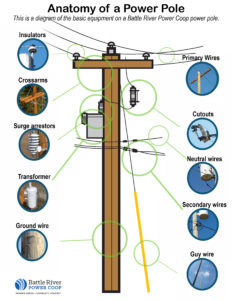What do you see when you look up at a power pole? A power pole is a post used to support overhead power lines and public utilities, such as power lines and related equipment such as transformers.
Electrical wires and cables are routed overhead on utility poles to keep them insulated from the ground and out of the way of people and vehicles. Most utility poles are made of wood, pressure-treated with a preservative for protection against rot, fungi, and insects.
The poles and lines themselves are called distribution lines and are part of an intricate system of equipment that safely delivers electricity to power homes.
But what is all that equipment attached to the pole? There are a few parts to a basic power pole that is erected and serviced by Battler River Power Coop (see diagram below). These include:
- Insulators which prevent energized wires from contacting each other or the pole
- Primary wires are at the top of a pole and carry hazardous high-voltage electricity from a substation
- Crossarms hold wires up on the pole
- Cutouts act like a fuse: they open when there’s a problem with the line
- Surge/Lightning arrestors protect the pole and the equipment from lightning strikes
- Neutral wires are below the transformer. They balance out the amount of electricity on the system by feeding back to the substation
- Transformers convert higher voltage electricity from primary lines to lower voltages for homes and businesses
- Secondary wires carry lower voltage electricity from transformers to homes and businesses
- Ground wire runs the entire length of the pole and directs electricity on the pole safely to the earth
- Guy wires stabilize the poles.
Electricity is an important part of our everyday lives, but it’s also extremely dangerous. If you have a utility pole near your home, keep your distance. If a downed power line occurs nearby, never approach the area and call Battle River Power Coop to service the pole and line (1.877.428.3972).


